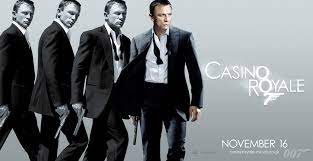2006’s Casino Royale remains the most popular James Bond film there is, and there are a few reasons why Daniel Craig’s first outing as 007 still resonates so much with audiences. Bringing things back to basics while also somewhat reinventing the franchise, Casino Royale was a powerful entry in a series that still captures the imagination. The film tops many James Bond movie ranking lists, as well as Daniel Craig Bond film ranking lists, even though Craig has done four more 007 films since Casino Royale.
Casino Royale existed outside the original 007 timeline, as it was the first and, so far, only James Bond film to act as a reboot for the franchise. Martin Campbell, who also directed GoldenEye, Pierce Brosnan’s first outing as Bond, was tapped to direct. The team also brought in a new actor to play 007 in Daniel Craig. With the franchise long overdue for revitalization, the writers crafted an origin story that showed James Bond attaining his 00 status, and how he came to be the world-famous secret agent audiences know.
Casino Royale remains the most popular amongst viewers for many reasons; virtually everything in the film was done right and executed with great aplomb, making for an exceptionally entertaining and satisfying experience. But its resonating popularity is more specifically attributed to two key factors: its evolutionary position within the franchise as a whole, and the main Bond woman, Vesper Lynd, played by Eva Green, who rewrote the concept of a “Bond girl.” Vesper, Bond’s greatest on-screen love since Teresa in On Her Majesty’s Secret Service (1969), offered the depth and complexity of character that previous Bond women and those since have failed to better. Casino Royale’s most emotional scene (for which Daniel Craig was responsible) directly centers around Vesper as she tries to cleanse her traumatized soul in the shower after witnessing a bloody stairwell fight. Though only in one film, Vesper significantly helps shape the plot as well as Bond’s own character, and she continued to influence him moving forward.
More crucially, Casino Royale was refreshing, redefining what a James Bond film could be following the more gadget-orientated and outlandish Pierce Brosnan era. It, therefore, had a powerful impact on audiences at the time, but the vision still holds up today. Casino Royale succeeded Brosnan’s last outing as Bond, Die Another Day (2002), an entry that polarized many longtime fans with its shoddy CGI and adolescent style. The producers needed a dramatic change of direction to keep audiences invested. Pierce Brosnan didn’t return for Casino Royale, which instead introduced Craig’s new take on James Bond, one that was more hands-on, more realistic, and more human, with his brute bluntness hiding a romantic heart and vulnerable streak. Audiences related more to this more Fleming-like Bond, who has his heart shattered by Vesper. It teaches him valuable lessons regarding trust and emotional detachment, a convincing character arc that translated well on screen as a fitting Bond film for the current times.
Beyond these two larger points, Casino Royale is simply a really well-crafted film. Its narrative is tight, its action fast-paced with interesting stunts, and its cinematography is beautiful. With an IMDb rating of 8/10, and a 94% Rotten Tomatoes score, it is no surprise Casino Royale regularly tops many James Bond ranking lists worldwide as the franchise’s arguable masterpiece. Following Die Another Day (2002) this is exactly what was needed: a gritty, mature, and realistic James Bond origin story, with action, love, heartbreak, integrity, and a freshness that has yet to be rivaled.

